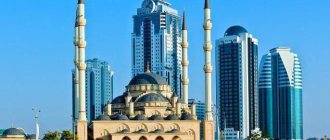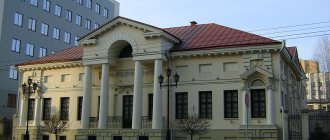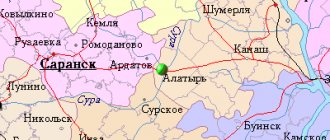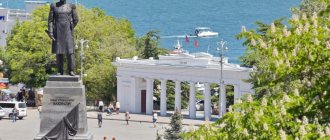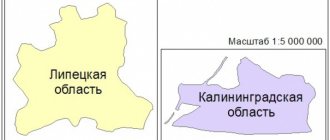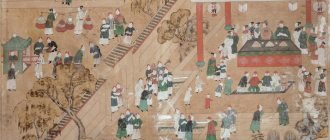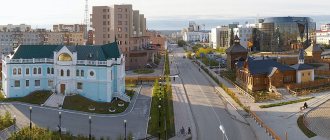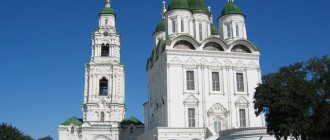We love
(Yaroslavl region)
OKATO code:
78218501
Founded:
1546
City since:
1546 City of district subordination (Lyubimsky district, Yaroslavl region)
Center:
Lyubimsky district
Telephone code (reference phone)
| 48543***** | — |
Deviation from Moscow time, hours:
0
Geographic latitude:
58°21′
Geographic longitude:
40°42′
Altitude above sea level, meters:
105 Sunrise and sunset times in the city of Lyubim
Church of the Resurrection of Christ (Voskresenskoye)[edit]
The Church of the Resurrection of Christ was built in 1825. During the Soviet years it was closed and desecrated, destroyed.
In 2003, the dilapidated temple was returned to the Church. In 2008, work began on the restoration of the temple
An annual celebration is held on the day of remembrance of St. Sylvester of Obnor, May 8.
The Monk Sylvester, the wonderworker of Obnorsky, was a disciple and tonsure of the Monk Sergius of Radonezh. From him he received a blessing to live in the desert and settled in a dense forest on the banks of the Obnora River, where the village of Voskresenskoye now stands.
Address:
Yaroslavl region, Lyubimsky district, village. Voskresenskoe.
Map
| We love: cards |
We love: photos from space (Google Maps) We love: photos from space (Microsoft Virtual Earth)
| We love you. Nearest cities. Distances in km. on the map (in brackets along roads) + direction. Using the hyperlink in the distance , you can get the route (information courtesy of the AutoTransInfo website) | |||
| 1 | Most Pure | 22 (25) | Z |
| 2 | Danilov | 35 (39) | SW |
| 3 | Buoy | 50 (60) | IN |
| 4 | Vokhtoga (Vologda region) | 54 (128) | WITH |
| 5 | Susanino (Kostroma region) | 56 (97) | SE |
| 6 | Nikolskoye (Kostroma region) | 64 () | YU |
| 7 | Gryazovets | 64 (74) | NW |
| 8 | Kostroma | 66 (158) | YU |
| 9 | Karavaevo (Kostroma region) | 71 () | YU |
| 10 | Nekrasovskoe | 77 (155) | YU |
| 11 | Sudislavl (Kostroma region) | 79 (194) | SE |
| 12 | Tutaev | 85 (146) | SW |
| 13 | Konstantinovsky | 87 () | SW |
| 14 | Yaroslavl | 93 (106) | SW |
| 15 | Poshekhonye | 93 (121) | Z |
| 16 | Galich | 96 (122) | IN |
| 17 | Krasnoe-on-Volga (Kostroma region) | 98 (193) | YU |
| 18 | Nerekhta | 100 (199) | YU |
| 19 | Volgorechensk | 105 (201) | YU |
| 20 | Vologda | 106 (122) | NW |
| 21 | Ostrovskoye (Kostroma region) | 109 (227) | SE |
| 22 | Plyos | 110 (229) | SE |
| 23 | Privolzhsk | 112 (211) | YU |
| 24 | Rybinsk | 114 (187) | Z |
| 25 | Shuiskoye (Vologda region) | 115 (216) | WITH |
| 26 | Dairy (Vologda region) | 119 (137) | NW |
a brief description of
Located at the confluence of the river. Studying in the district Obnora (tributary of the Kostroma), 123 km northeast of Yaroslavl. Railway station.
Territory (sq. km): 86
Information about the city of Lyubim on the Russian Wikipedia site
Historical sketch
Founded in 1546, in the 16th century. The city was called Lyubim. The name is from the Russian personal name Lyubim, very common in the 15th and 16th centuries.
Since 1708, the city of the Moscow province, since 1719 - in the Kostroma province of the Moscow province. Since 1777, the district town of Lyubim of the Yaroslavl governorship (since 1796 - Yaroslavl province).
In 1856, in the district town of Lyubim, Yaroslavl province, there were 7 churches, 334 houses, 76 shops.
Since the 1920s the village of Lyubim, from April 20, 1938 again the city of Lyubim.
Economy
Forestry and local industry enterprises, meat processing plant.
Culture, science, education
The poet L.N. was born in Lyubim. Trefolev, author of the famous song “Kamarinskaya”.
Museums, galleries, exhibition halls
Lyubimsky Museum of History and Local Lore 152470, Yaroslavl region, Lyubimsky district, Lyubim, st. Oktyabrskaya, 11 Phone(s): (48543) 23-370 Website: https://lubim-muzey.ru/
| Population by year (thousands of inhabitants) | |||||||
| 1856 | 2.2 | 1989 | 7.1 | 2006 | 6.0 | 2015 | 5.2 |
| 1897 | 3.0 | 1992 | 6.9 | 2007 | 5.9 | 2016 | 5.1 |
| 1913 | 3.3 | 1996 | 6.7 | 2008 | 5.8 | 2017 | 5.1 |
| 1926 | 3.7 | 1998 | 6.5 | 2010 | 5.6 | 2018 | 5.1 |
| 1939 | 7.1 | 2000 | 6.4 | 2011 | 5.6 | 2019 | 5.1 |
| 1959 | 7.6 | 2001 | 6.4 | 2012 | 5.3 | 2020 | 5.0 |
| 1970 | 7.7 | 2003 | 6.3 | 2013 | 5.3 | 2021 | 5.0 |
| 1979 | 7.4 | 2005 | 6.0 | 2014 | 5.2 | ||
Content
- 1 Temple of John the Baptist (Butyrki)
- 2 Church of the Resurrection of Christ (Voskresenskoye)
- 3 Church of the Assumption of the Blessed Virgin Mary (Zakobyakino)
- 4 Cathedral of the Epiphany (We love)
- 5 Temple of the Presentation of the Blessed Virgin Mary (We Love)
- 6 Temple of the Entry of the Blessed Virgin Mary into the Temple (Pavlovka)
- 7 Church of the Nativity of John the Baptist (We love)
- 8 Temple of the Tikhvin Icon of the Mother of God (We Love)
- 9 Temple of the Savior Not Made by Hands (Michael the Archangel)
- 10 Temple of the Savior Not Made by Hands (Filippovo)
Temple of the Savior Not Made by Hands (Michael the Archangel)[edit]
The Church of the Savior Not Made by Hands was built in 1772. The last local priest, Father Mikhail Rozov, was repressed and shot in 1937; the exact year the church was closed is unknown. Subsequently, the temple was desecrated, turned into a granary, and a substation was installed in the altar. Most recently, the temple was completely abandoned.
At the time of its transfer to believers in May 2000, the temple was in deplorable condition. On June 7, 2000, the community was registered.
The garbage was taken out of the temple, the windows on the first floor were covered with polyethylene, after which, for the first time after many years of desolation, a thanksgiving prayer to the Lord was served.
Divine services are held regularly.
Address:
Yaroslavl region, Lyubimsky district, village. Michael the Archangel.
Church of the Assumption of the Blessed Virgin Mary (Zakobyakino)[edit]
The temple was built in 1846 at the expense of parishioners on the site of a burnt wooden one.
The throne in the name of St. Sergius, abbot of Radonezh, was built in 1848 at the expense of Metropolitan Philotheus of Kyiv, a native of the village of Zakobyakino.
There was a parochial school at the church.
During Soviet times, the temple was not closed. The popularly revered Archpriest John of Vladimir, who was rector at the end of the 19th century, was buried near the church.
Address:
Yaroslavl region, Lyubimsky district, village of Zakobyakino.
Cursed city
Eternal flame in Lyubim. Photo by Vladimir Zakharin
If you don't get there, you can't swim
Judging by the www-encyclopedia, there should be an airport in Lyubim. Airport?! Yes, planes have never even flown over this place.
It's hard to get into Love. And this is a sure sign of the right place. Of course, you can get to such a city by your own car, but who needs this and why?
There are no dachas here. This is not a resort. There are no historical monuments here. “Cultural figures” did not live here. There seems to be absolutely nothing to do in such a place. Except for one thing – it’s surprisingly easy to breathe here. The air is so clean that after getting off the bus, after a short time I felt that I was starting to feel dizzy - from the excess oxygen. Acclimatization took two days.
The intercity bus goes to Lyubim for more than three hours (from Yaroslavl). More precisely, three hours 45 minutes through Danilov and three hours 10 minutes through Sereda. And this bus is the old “Pazik”, which, snorting and falling apart as it goes, trudges at an average speed of 40 kilometers per hour - along an endless two-lane highway, past fields and forests (the closer to Lyubim, the more forests), on which the farther , the less often you come across oncoming cars. And in the end, in the last hour of the journey there are none at all.
| What's in Lyubim | What's missing from Lyubim |
| newspaper | Internet |
| hotel | night club |
| museum | prostitution |
| restaurant | supermarket |
| printing house | Taxi |
| bakery | TV studio |
| church | FSB |
There is one train passing through the local station, but it is the kind of train that no one should travel on. Because it belongs to the class of those trains that go to and from the zone.
More recently, Lyubim was a dead end on the map. There was nowhere to go further from there. After the construction of the new road, a direct route to the Vologda region appeared. This spurred the growth of the local bakery, but had no effect on local consciousness.
It is difficult for local residents to imagine a person who simply came to Lyubim without having any relatives or connections here. And therefore, people who decide to do this arouse genuine curiosity and fear.
At a local hotel, more like a hostel, I was the only guest for a week. And the arrangement there was more reminiscent of a friendly conversation at the prosecutor's office than a simple procedure for issuing keys.
King with a bird
“Will you have any cabbage soup?” - asks the hospitable server from the Sokol restaurant (one can hardly call her a waitress, because she pours the soup and serves it). Thursday evening, I am the only visitor, and I was already warned that the restaurant is actually closed because they are preparing for a banquet on Friday, but since I came, then... I get beef schnitzel in addition to the cabbage soup.
The king is galloping along the wall on a horse with a bird in his hand (the horse squints with a kind eye). A well-fed lynx stalks angrily down a tree, chasing a fat bunny. A squirrel, human-sized, holds a cone that can kill an elephant. An ancient Russian man and woman (she is bare-breasted) touch each other with the backs of their hands, and above them - in the heights - two schematic birds fly away in different directions. And two conditional owls are watching this chaos from a hollow. The entire extravaganza is carved out of wood and occupies the entire walls - wherever possible. Seeing such epic paintings, the owners of the Dacha restaurant must die of envy, because the Russian style of wood carving here in Lyubim has been brought to a surrealistic concentration.
But few people see all this beauty. Because in Lyubim people don’t go to a restaurant for lunch so easily. Why, if you can still get to the house on foot. Therefore, only the main life events are celebrated in the restaurant - weddings. Rich weddings.
Ivan and the Cossacks
Ivan the Terrible hunted in the vicinity of Lyubim. With falcons. So, in any case, believes the local fantasy, which christened one of the local groves falcon.
The last war that took place in Lyubim was the Russian-Polish war. This is not about the Soviet-Polish campaign of 1919–1920, but about the Time of Troubles. Then one of the stray Cossack detachments - by chance, on the way to Vologda - burned and robbed Lyubim.
This was the biggest disaster in the history of the city - not counting, of course, the fire that happened at 9 a.m. on July 18, 1897. Then the telegraph, post office, zemstvo and city government, hospital, pharmacy, almshouse, church, tannery and sawmill and many residential buildings burned down.
Lyubim flourished in the 16th century. Everything else is a sunset that lasts forever.
"Chaika" is not "Falcon"
There are 2 catering outlets in Lyubim. Cafe "Chaika" and restaurant "Sokol".
Friday – restaurant with special service. So, on Friday I have lunch at the Chaika cafe. Lunch costs a little over 30 rubles (what is “small” for me includes a salad of one bitter tomato), and the menu is written down to the penny. But usually only visiting merchants dine here. Locals drink here.
"Chaika" is not "Falcon". This is a completely different place. The dialogue between two drunken men (in the silent presence of a drunken blonde) at the next table is reminiscent of the novels of Russian classics. Here it is (verbatim):
“What right does she have to judge us?”
-What right do you have to judge her?
- I'll kill you!
“They deprived you of your freedom, and you want them—life.” God gave life. He can take it away. There is God and there is Satan. Who are you, Satan?
- A child stole a jar of stew or jam, and he was sentenced to three years. And our oligarchs steal as much as they can - and nothing.
- Do you have the right to judge?
– What right did they have to judge me?
And again, let's go and talk about God's judgment and human judgment. Here history is forever frozen on the themes of Dostoevsky.
Neither full nor hungry
Monk Gennady was driven out of Lyubim. It was in 1529, but the day of his expulsion is forever imprinted in the memory of generations. As the rumor goes, Gennady wished the villagers forever “to be neither poor nor rich, neither well-fed nor hungry.”
After leaving Lyubim, Gennady did not go far - 25 versts away he founded a monastery, on Lake Surskoe. Over time, he was recognized as a saint. And the image of Gennady Lyubimogradsky was carried around the city many times in the past - either after a fire, or to prevent cholera, or even simply on holidays.
The only book about the history of Lyubim was written by Vladimir Lavrovich Orlov, a descendant of local priests. “We love how we have stood since time immemorial in this form, and will continue to stand unshakably forever. People have lived and will continue to live. It has always had three thousand inhabitants and five churches.” And it’s true - there are still five churches in the city, not a single one has been demolished (but only one remains operational). The number of residents, however, has doubled.
And the Gennadiev Monastery is being revived. But getting to it is not much easier than in the 16th century.
Love–Moscow
Brief chronology of Lyubim
Before 1379 , Sylvester founded a monastery on Obnor, 20 versts from the present city.
1529 Gennady founded a monastery on Lake Surskoye, 25 miles from the present city.
1538 Tsar Ivan Vasilyevich (Grozny) orders the construction of a fortress on the Ucha and Obnora spit.
1560 The first chronicle mention of Lyubim, the city was allocated “for subsistence” to Wilhelm von Furstenberg, the captured master of the Livonian Order (1500 - June 1568).
1612 A detachment of Cossacks, making their way to Vologda, burns Lyubim along the way.
July 1897 A big fire started in the hay barn of nobleman Mikhailov; half the city burned down
July 1910 An outbreak of cholera in the Zakobyakinsky volost of Lyubimsky district.
July 1919 First Ossetsky rebellion (center - the village of Zakobyakino).
February 1920 Second Ossetsky rebellion (center - the village of Zakobyakino).
Church of the Entry of the Blessed Virgin Mary into the Temple (Love)[edit]
On the site of the modern temple there was the Afanasyevskaya men's hermitage, abolished in 1764.
In 1788, at the cemetery that remained from the monastery, the Vvedensky Church was built, which has survived to this day practically unchanged, except for the bell tower, rebuilt in the middle of the 19th century.
The temple did not close during Soviet times, mainly preserving the decoration of the 18th-19th centuries, as well as some of the icons transferred to it from the closed churches of the Lyubimsky district.
Address:
Yaroslavl region, Lyubim, st. Ucha embankment.
Telephone:
+7(48543) 2-17-20
Private advertisements in Lyubim, in the Yaroslavl region and in Russia
To add an advert
Yaroslavl
How to transport the deceased
Yaroslavl
Packaging materials and equipment
Yaroslavl
Drug treatment clinic New Method - Treatment of alcoholism and drug addiction
Yaroslavl
Buy metal beds at a good price
123ru.net
- minute-by-minute news with a daily archive. Only here we have all the main news of the day without political censorship. “123 News” - absolutely all points of view, sober analysis, civilized debates and discussions without mutual accusations and insults. If you don’t like it, don’t want to hear it, don’t read it, read it, be mutually polite and correct in your statements. Remember that not everyone's point of view coincides with yours. Respect the opinions of others, even if you defend your views and your position. 123ru.net is a news observer. We do not impose our vision on you, we give you a snapshot of the events of the day without censorship and without cuts. News as it is—online with minute-by-minute archives for all cities and regions of Russia, Ukraine, Belarus and Abkhazia. 123ru.net - live news live! A quick search from 123ru.net is not only the opportunity to be the first to know, but also the advantage of reporting breaking news instantly in any language in the world and being heard right away. You can add your news at any moment - here.
Department of Tourism
Symbols of the Yaroslavl region
Coats of arms of cities of the Yaroslavl region
Yaroslavl
| Approved by: the municipality of the city of Yaroslavl on August 23, 1995 Description of the coat of arms: “In the silver field of the heraldic shield, a rising black bear is turned to the right, holding a golden ax on his left shoulder with his left front paw, facing the blade upward; The bear's right front paw is raised above the left. The heraldic shield is topped with the image of Monomakh’s cap.” (Appendix 2 to the Decision of the Municipality of the City of Yaroslavl No. 35 of August 23, 1995) History of the coat of arms: In the Yaroslavl lands there is a legend associated with the history of the founding of the city. Yaroslav the Wise walked with his squad, surveying the Rostov lands. The road was desolate, deserted, the area overgrown with forest was wild. The prince fell behind his squad in a dense forest on the right bank of the Volga, not far from the confluence of the Ktorosteya River. Suddenly a bear appeared from the ravine and rushed at the prince. Without being confused, he managed to hit her with an ax. In memory of this incident, Yaroslav built a wooden church at the site of the incident from the forest cut down here, and settled the city founded there with settlers from Rostov. (Based on materials from the article by I.A. Tikhomirov “On some Yaroslavl coats of arms” in the collection “Proceedings of the Third Regional Historical and Archaeological Congress”, 1909) Heraldry of Yaroslavl on the official website of the city |
Rybinsk
| Approved by: Rybinsk Council of Deputies on July 17, 2001 Description of the coat of arms: “The coat of arms of the Rybinsk municipal district of the Yaroslavl region is a scarlet heraldic shield. In a scarlet field there is an azure belt, above which there is a green shore with a golden pier, from behind which comes a black rebel bear holding a golden ax in his left paw on his left shoulder; gold double bridges extend over the waistband; Below the bridge, the belt is burdened with two facing silver sterlets.” (Appendix 3 to the Decision of the Rybinsk Council of Deputies No. 91 of July 17, 2001) History of the coat of arms: On June 20, 1778 (law No. 14765; August 31, 1778), the first city coat of arms of Rybinsk was approved (together with other coats of arms of the Yaroslavl governorship). The coat of arms was composed by a fellow king of arms von Enden. Symbols of Rybinsk on the official website of the city |
Pereslavl - Zalessky
| Approved by: Decision of the City Duma of February 7, 2002. Description of the coat of arms: “In a black field there are two golden herrings, one above the other, the lower one facing.” (clause 3.1 of Decision No. 14 of the City Duma of February 7, 2002) History of the coat of arms: The basis of the coat of arms of the municipal formation “city of Pereslavl-Zalessky” is taken from the historical coat of arms of the county town of Pereyaslavl, Vladimir province, Supremely approved on August 16, 1781, the true description of which reads: “At the top of the shield is the coat of arms of Vladimir. In the bottom there are golden herrings, in a black floor, as a sign that this city sells these smoked fish.” Black color in heraldry symbolizes prudence, wisdom, modesty, honesty and the eternity of existence. Gold is a symbol of strength, greatness, intelligence, generosity. The black field of the coat of arms is damasked with a shadowy wave-like ornament, which complements the content of the coat of arms of the city, located on the shore of Lake Pleshcheyevo. Symbols of Pereslavl-Zalessky on the official website of the city |
Rostov Veliky
| Approved by: Decision of the Duma of the Rostov Municipal District of December 27, 2001. Description of the coat of arms: “In a scarlet field there is a silver deer, horns, mane and golden hooves.” (clause 3.1 Decision No. 73 of the District Duma dated December 27, 2001) History of the coat of arms: The basis of the coat of arms of the Rostov municipal district is taken from the historical coat of arms of the district city of Rostov, Yaroslavl province, approved on August 31, 1778, the original description of which read: “On the scarlet floor there is a silver deer horns, mane and hooves are golden.” Silver in heraldry is a symbol of purity, wisdom, nobility, peace, and mutual cooperation. Gold is a symbol of strength, greatness, wealth, intelligence, generosity. Chervleny (red) is a symbol of courage, dedication, heroism, just struggle and life. Symbols of Rostov the Great on the official website of the city |
Uglich
| Approved by: Decision of the District Duma of March 31, 1999. Description of the coat of arms: “The coat of arms of the city of Uglich and the Uglich municipal district is a heraldic shield. In a scarlet (red) field, Tsarevich Dimitri is in gold, with one visible bow under the orb, a crown with a purple cap, a purple dress decorated with gold and precious stones and purple boots, in the prince’s right hand is a silver knife, a golden halo.” (Appendix 1 to Decision No. 72 of the District Duma of March 31, 1999) History of the coat of arms: In Uglich, the heir of Ivan the Terrible, Tsarevich Dmitry, died under mysterious circumstances. Some historians consider the death of the prince to be a political murder, planned and carried out by Boris Godunov. After the death of the prince, Godunov opened his way to the throne. Other historians adhere to the version of the prince’s suicide (Dmitry suffered from epilepsy and could actually seriously injure himself in a seizure). The coat of arms was created by a fellow herald master von Enden, but he used a prototype that was available at that time. The image of Tsarevich Dmitry appeared in the Znamenny armorial of 1729, as a sign for the Uglich regiments (“Tsarevich Prince Dmitry in royal attire, a princely cap with a cross, a knife in his right hand, a lamb under the bosom of his left hand, a red field, gold robe and hat”) . Precisely because the coat of arms existed until 1778, it did not receive an image of the Yaroslavl bear on the shield, as a sign of belonging to the Yaroslavl governorship. Symbols of Uglich on the official website of the city |
Tutaev
| Approved: June 16, 1995 Description of the coat of arms: “In a golden shield beveled on the right at the top there is an azure (blue, light blue) wavy bandage, accompanied on the sides by narrow black bands; below is a wreath of thirteen scarlet (red) garden roses with green stems and leaves, tied with an azure ribbon and having inside in a silver field a black rising bear holding a golden ax on his shoulder with his left front paw.” History of the coat of arms: The coat of arms of Tutaev is composed of two coats of arms: the coat of arms of the city of Romanov and the coat of arms of the city of Borisoglebsk, approved on August 31, 1778. In 1822, when the two cities of Romanov and Borisoglebsk were united into one Romanov-Borisoglebsk, a decision was made to unite the coats of arms. In the upper part of the heraldic shield was placed the coat of arms of the city of Romanov (as the older one), and in the lower part the coat of arms of the city of Borisoglebsk. Symbols of Tutaev on the official website of the city |
Gavrilov-Yam
| Description of the coat of arms: In a cut gold, silver and gold field there is a scarlet harness with a scarlet bell suspended from it, below in silver there are three scarlet through rhombuses (one and two) standing in a column. In the free part there is the coat of arms of the Yaroslavl region. History of the coat of arms: The Gavrilov-Yam coat of arms is based on yam utensils and four rhombuses. A horse arch with a bell indicates the historical name of the city, associated with the settlement of coachmen on the Moscow, Suzdal, Yaroslavl highway. The diamonds symbolize the weaving shuttles, that is, the industry of the city. In the left corner there is a bear as a symbol of the Yaroslavl region. Belonging to it is also marked with the traditional yellow color for the Yaroslavl region. |
Myshkin
| Approved by: Decision of the Assembly of Deputies of the Myshkinsky Municipal District of the Yaroslavl Region dated December 28, 2006. Description of the coat of arms: “In a green field there is a small shield, divided into two parts in a ratio of 4:3. In the upper silver part there is a defeated image of a brown bear with an ax on the left shoulder. In the scarlet part there is a gray mouse.” History of the coat of arms: The Myshkin coat of arms was approved on June 20, 1778 (law No. 14765; August 31, 1778) along with other coats of arms of the Yaroslavl governorship. |
Danilov
| Approved by: Regulations of the Danilovsky Municipal District dated July 29, 1999. Description of the coat of arms: The coat of arms is a shield divided in half at random, from bottom to top, from left to right, the upper part of the coat of arms is a silver field, the lower part is a chess field with alternating green and white cells. A bear emerges from the chessboard into the silver one, holding in its left paw a golden ax with the same handle. (clause 1 Decision of the Danilovsky Municipal District No. 122 of July 29, 1999) History of the coat of arms: During the reign of Peter I, there was a stud farm in the Danilovskaya Tsar's Sloboda that supplied horses for the army. During one of his trips from Moscow to Vologda and Arkhangelsk, Peter I made a stop in Danilovskaya Sloboda and inspected a stud farm. He was pleased with the plant and before leaving, he went to the wooden church of St. Hodegetria, which stood on the highway. Peter left the church, furious at its untidiness and wretchedness. Peter did not like church luxury, but he also did not tolerate dirt in holy places. The tsar reprimanded the local clergy and nobility of Danilovskaya Sloboda, as foreign guests came to the church. To please the emperor, the local nobility and clergy laid the foundation for a new stone winter cathedral with a bell tower, which began service in 1713 and was named Smolensk. A letter was sent to Peter I about the opening of the cathedral and a gift made by Danilov craftsmen was enclosed—a silver travel chess set in a silver case. Peter I loved to play chess. According to the story of P. F. Kalikin, in the early 60s they were in the Hermitage in exhibitions dedicated to Peter I. Therefore, when the coat of arms of the city of Danilov was assigned, it was given a silver and chess field in memory of the gift to the highest person - Peter I. Green the color symbolizes excellent meadows for grazing, one of which was called Red Meadow, that is, good meadow. Danilov symbols on the city website |
We love
| Approved: June 20, 1778 Description of the coat of arms: “The shield is divided in half: from a green field, cut into several parts by black, a bear emerges into a silver field, proving that this city belongs to the Yaroslavl viceroyalty.” History of the coat of arms: The coat of arms was composed by a fellow king of arms von Enden . In the 19th century after the reform of B. Kene, the coat of arms of Lyubimsky district was often decorated with a crown, and in this form the coat of arms is often used today. History of Lyubim on the city website |
Poshekhonye
| Approved: June 20, 1778 Description of the coat of arms: “In a golden field, crosswise, there are two green jagged stripes: in the middle in a silver shield is the coat of arms of the Yaroslavl governorship.” History of the coat of arms: The Poshekhonye coat of arms was approved on June 20, 1778 (law No. 14765; August 31, 1778) along with other coats of arms of the cities of the Yaroslavl governorship. The coat of arms was composed by a fellow king of arms von Enden. |
Coats of arms of municipal districts
Yaroslavl Municipal District (Yaroslavsky District)
| Approved by: Decision of the Meeting of Representatives of the Yaroslavl Municipal District of the Yaroslavl Region dated May 21, 1999 Description of the coat of arms: In a silver field there is a green tip and on top of an emerging wavy azure (light blue, dark blue) column there are two black opposing bears, of which the right one holds on the right, and the left on the left shoulder on a golden ax, while their free paws are raised and touching. History of the coat of arms: The coat of arms of the Yaroslavl district is based on the historical coat of arms (a black bear with an ax in a silver field) of the city of Yaroslavl, around which the Yaroslavl district is located. Two bears greeting each other allegorically show the city of Yaroslavl and the Yaroslavl region, whose life is inextricably linked historically, territorially, economically and spiritually. Silver in heraldry is a symbol of simplicity, perfection, wisdom, nobility, peace, and mutual cooperation. Gold in heraldry is a symbol of the highest value, strength, strength, generosity, and sunlight. Black color in heraldry is a symbol of prudence, severity, solemnity and eternity. The green tip reflects the beautiful nature of the area and its agriculture. Green color is a symbol of fertility, hope, life and health. The blue wavy pillar shows the great Russian river Volga, on the banks of which the region is located. Blue color is also a symbol of honor, beauty and virtue. Official website of the Yaroslavl Municipal District |
Rybinsk Municipal District
| Approved by: Decision of the Municipal Council of the Rybinsk municipal district dated March 26, 2008. Description of the coat of arms: “The coat of arms of the Rybinsk municipal district of the Yaroslavl region is a scarlet heraldic shield with the image of a black bear facing to the right (from the viewer to the left), holding in its left paw on the left shoulder a gold axe. At the bottom of the heraldic shield there is an azure wavy belt, inside of which two aligned golden sterlets are depicted.” (Appendix No. 3 to the decision of the Municipal Council of the Rybinsk Municipal District No. 276 of March 26, 2008) History of the coat of arms: The coat of arms, in the language of symbols and allegories, reflects the historical, cultural and natural features of the region, is associated with the coat of arms of the Yaroslavl region and is an organic continuation of the heraldic history of the Yaroslavl region. The color red symbolizes courage, courage, and fearlessness. A bear with an ax means that the area belongs to the Yaroslavl region. Gold in heraldry is a symbol of the highest value, strength, strength, generosity, and sunny color. Black color in heraldry is a symbol of prudence, severity, solemnity, and eternity. The azure wave-like belt reflects the multiplicity of reservoirs in the area. Two golden sterlets indicate the presence and abundance of fish. |
Gavrilov-Yamsky Municipal District
| Approved by: Decision of the Meeting of Representatives of the Gavrilov-Yamsky Municipal District on October 24, 2002. Description of the coat of arms: “In a green field there is a silver left baldric, in the center of which is a black bear holding a golden ax with a scarlet shaft, and accompanied at the top by a silver weaving shuttle filled with black and placed in a pillar, and below - a golden sheaf of flax, with azure flowers, inclined to the left.” (clause 1 of the Decision of the Meeting of Representatives of the Gavrilov-Yamsky Municipal District No. 141 of October 24, 2002) History of the coat of arms: A bear with an ax testifies to the belonging of Gavrilov-Yam and the region to the land of Yaroslavl, where the clubfoot, defeated by Grand Duke Yaroslav the Wise, became the main symbol our region. And finally, purely Gavrilov-Yamsky features - a shuttle from the era of the Lokalovskaya manufactory, which, in modern language, became a city-forming enterprise and a sheaf symbolizing the agricultural labor of the inhabitants of the region. Symbols of Gavrilov-Yam on the official website of the municipal district |
Nekrasovsky Municipal District
| Description of the coat of arms: In a scarlet field there is a silver belt connected to a narrow wavy silver belt shifted to the right. The top of the belt is accompanied by a silver ball with a gold handle on top of two cross gold reeds. Below is a golden well in the form of a golden frame and two supports, to which a silver ladle with a golden handle is attached. History of the coat of arms: The district traces its history back to 1214, the date of the founding of the village of Greshnevo. Since that time, the area has been known for its salt production. It was the extraction of salt in these places that gave its name to the village, and later, for a short time, to the region. The salt production in the coat of arms is reflected by a salt well in the form of a log house and supports on which a ladle with a handle is mounted. The main water artery of the region: Volga, Solonitsa are shown with a silver belt with a narrow, wavy belt shifted to the right. Gold is the color of the sun, hidden wealth, grain, fertility and symbolizes splendor, respect. Silver color - perfection, nobility, peace, cooperation. The region is proud of its wonderful fellow countrymen who, with their talent, selfless work, and military feats, have increased the glory of their small homeland. The red color of the field of the coat of arms is a symbol of labor, life-affirming strength, courage, celebration, and beauty. The region rightfully considers N.A. its fellow countryman. Nekrasova. As a token of gratitude to the author, the composition of the coat of arms includes a sword with a gold hilt on top of two crossed arrows - the figure of the Nekrasov coat of arms. |
Borisoglebsky municipal district
| Approved: by the decision of the Meeting of Representatives of the Borisoglebsk Municipal District on October 12, 1999 Description of the coat of arms: In a silver field there are two riders: one on a black horse, the other, behind him on a scarlet (red); the first - with a golden beard and mustache, in a scarlet cloak and boots, and in a green caftan, decorated with gold, in scarlet pants and in an old princely cap, decorated and trimmed with gold, scarlet in the middle, green on the sides, holding in his right hand (right hand ) a golden spear with a scarlet pointed flag: the horse's headdress is golden, the saddle is green, decorated with gold; the second horseman is the same, but without a mustache and beard and equipped in the same way, but replacing the scarlet with green, and the green with scarlet. History of the coat of arms: Two horsemen symbolically represent princes Boris and Gleb, killed by their brother Svyatopolk. The village of Borisoglebsky and the entire region, which was once part of the inheritance of the Rostov prince Boris, bear their names. Thus, the coat of arms speaks of the name of the area, reflecting its historical past. |
Pereslavl Municipal District
| Approved by: Decision of the Meeting of Representatives of the Pereslavl Municipal District on June 28, 2001 Description of the coat of arms: Rectangular green panel with a width to length ratio of 2:3, bearing along the lower edge a blue stripe 3/10 of the width of the panel and close to it a white stripe 1/30 of the panel ; in the middle of the green part there is a yellow church dome on a white drum with black windows; on the blue stripe under the dome there are two yellow fish from the coat of arms. (Appendix 1 to Decision No. 46 of June 28, 2001) History of the coat of arms: In the coat of arms of the Pereslavl Municipal District, gold symbolizes ears of bread, the fertility of the earth, and sunlight. Gold in heraldry is a symbol of strength, greatness, wealth, intelligence, and generosity. The church dome symbolizes the Orthodox traditions of the population and the numerous reviving churches in the area. The green color shows the open spaces and forests of the Zalessk Territory National Park. Green color in heraldry is a symbol of spring, hope, life and health. Two fish are a historical symbol of the Pereslavl land. A stylized image of the Pereslavl vendace (herring) is traditionally present in the coat of arms of the city of Pereslavl-Zalessky, the center of the municipal district. Blue color is a symbol of honor, beauty and virtue. Silver in heraldry - purity, wisdom, nobility, peace, mutual cooperation. The coat of arms, in the language of heraldic symbols, harmoniously reflects the historical, geographical and natural features of the surrounding area of the circle. |
Nekouz Municipal District
| Approved by: Decision of the Meeting of Representatives of the Nekouz Municipal District dated July 27, 2000 Description of the coat of arms: The field of the heraldic shield diagonally from right to left and downward is divided by a blue image of a river making two of a splinter and symbolizing the Sit River. On the left half of the coat of arms, on a white background, part of the armor of a Russian warrior is depicted - a helmet and a sword, symbolizing the centuries-old history of the region. On the right half of the coat of arms there is a sheaf of flax on a red background, symbolizing the agricultural direction, which is the main one in the economy of the district. (Appendix 1 to Decision No. 5 of July 27, 2000) History of the coat of arms: The Bogatyr helmet symbolizes the famous battle on the Sit River. At the bottom of the coat of arms is a sheaf of flax, for which the area has long been famous. Official website of the administration of the Nekouz municipal district |
Breitovsky Municipal District
| Approved by: Decision of the Meeting of Representatives of the Breytovo Municipal District of the Yaroslavl Region dated March 9, 2006. Description of the coat of arms: In the upper part of the heraldic shield there is the word “Breytovo”, meaning the name of the district center; in the upper left part there is a bear with an ax on a red background, which means that the region belongs to the Yaroslavl region; in the lower right part there is a yellow ear, indicating the agricultural orientation of the economy; a seagull on a blue background reflects the geographical feature of the Breitovsky district. (clause 2 to Decision No. 116 of March 9, 2006) History of the coat of arms: The emblem was created back in the 1970s by artist Pavel Mikhailovich Gorbuntsov and approved by the bureau of the district committee of the CPSU. A seagull over the sea is a symbol of the Sit River and the Rybinsk Reservoir. Official website of the Breitovsky municipal district |
Coats of arms of rural settlements
Petrovsk
| Approved: June 20, 1778. Description of the coat of arms: “The shield is divided into two: a bear emerging from a green field into a silver field, proving that this city belongs to the Yaroslavl governorship.” History of the coat of arms: The coat of arms of Petrovsk was approved on June 20, 1778 (law No. 14765; August 31, 1778) along with other coats of arms of the cities of the Yaroslavl governorship. The coat of arms was composed by a fellow king of arms von Enden. Gold is a symbol of wealth, harvest, stability, respect and intelligence. Silver is a symbol of purity, perfection, peace and mutual understanding. Green color is a symbol of nature, health, and growth in life. Black color is a symbol of modesty, wisdom, and the eternity of existence. Symbols on the official website of Petrovsk |
Semibratovo
| Approved: January 25, 2008 Description of the coat of arms: “In a scarlet field there are seven golden ears of wheat (the middle one in a column, three on each side of it in a fan shape), the stems of which are entwined with azure ribbons, standing on a golden ring half extending from below, filled with azure” . History of the coat of arms: Seven ears of corn entwined with three azure ribbons and means that seven territories are united to resolve issues of local importance to the population. The blue ribbons with which the ears are intertwined show the main enterprises of Semibratovo. Seven is a magical, magical number, a sign of perfection, order and completeness. The ear is a symbol of growth and renewal. The three blue ribbons with which the ears are entwined allegorically indicate three rivers - the Ustye River, which turns sharply to the south near the village of Semibratovo, the Kotorosl River, with which the Ustye River merges, and the Vyoksu River, flowing from Lake Nero and seven kilometers after the source merges with Ustye River. Lake Nero itself is shown with the azure that fills the gear; the bends of the ribbons indicate the peculiarities of the flow of rivers: their fast flow, whimsical nature, wandering of the channel, which continuously bends, often branching into branches and forming medians and floodplain islands. In addition, blue ribbons also indicate the main enterprises: factories: gas purification equipment, a branch of the Research Institute of Industrial and Sanitary Gas Purification (NIIOGAZ). Azure (blue) is a symbol of lofty aspirations, truth, honor, sincerity, virtue, clear skies and expanses of water. The golden gear has multi-valued symbolism: - allegorically reflects the first local production - grain processing at Isad water mills, and its golden color - the main agricultural areas of production. — the Federal Highway “Kholmogory” Moscow - Kholmogory passes through the village; Northern Railway leading to Arkhangelsk and Vorkuta, and to the east of Russia; — the famous tourist route “Golden Ring of Russia” passes through Semibratovo, about 100 km long and reflected in gold. Gold symbolizes wealth, justice, respect, generosity, lofty thoughts, nobility, and dignity. Red color is the color of activity, sun, energy, symbolizes love, courage, boldness, generosity, as well as blood shed for faith and the fatherland. |
Rural settlement Ivnyakovskoye
| Approved: May 28, 2008 Description of the coat of arms: In a silver field there are three green willow branches in a column (the middle one below), accompanied at the head by an azure star with eight rays, filled with gold. In the free part there is the coat of arms of the Yaroslavl region. History of the coat of arms: Silver (field of the coat of arms) is a symbol of simplicity, perfection, wisdom, nobility, peace. Willow branches are an indication of the name of the settlement and the unique flora in which willows predominate. The willow, according to most literary sources, is a symbol of the Bible: “... because it, like a never-cut source of vitality, constantly grows back the cut branches.” In the Middle Ages, willow was valued as one of the plants that was able to create a barrier or block pathogenic substances and thereby help cure the disease. The number “3” (three branches) is a primordially Christian number. Trinity: God the Father, God the Son and the Holy Spirit, an expression of spiritual purity and clarity. The three branches are also a symbol of the three main territorial units of the Ivnyakovsky rural settlement: the village of Ivnyaki, the village of Karachikha and the village. Sarafonovo. Three willow branches, depicted stretched upward, also symbolize the settlement’s desire for development, and an azure star with eight rays filled with gold is a symbol of the right path. The coat of arms of the Yaroslavl region reflects the affiliation of the municipality with the subject of the Russian Federation. Official website of the administration of the rural settlement of Ivnyakovsky |
Coats of arms of now defunct cities
City of Mologa
| Approved: June 20, 1778 Description of the coat of arms: “In the shield, the silver, third part of the shield contains the coat of arms of Yaroslavl; in two parts of that shield, in an azure field, part of an earthen rampart is shown, trimmed with a silver border or white stone.” History of the coat of arms: The unique historical city of Mologa, which existed for almost eight centuries, went under water in 1946-1947, upon completion of filling the Rybinsk reservoir to the planned level of 102 m. In total, 13% of the territory of the Yaroslavl region was flooded. Only a few heads of churches remained above water. By 1950 they went under water. Author of the coat of arms: Comrade King of Arms von Enden. History of the city of Mologa |
City of Romanov
| Approved: June 20, 1778 Description of the coat of arms: “A river flows in a golden field; on both sides of it there is a black stripe.” History of the coat of arms: Already in 1822, when two cities were united into a single Romanov-Borisoglebsk, a project for a united coat of arms arose. The coat of arms of Romanov was placed in the upper part of the shield, and the coat of arms of Borisoglebsk was placed in the lower part. In 1995, the authorities of the Tutaevsky municipal formation approved a coat of arms in which the ancient coats of arms of Romanov and Borisoglebsk are combined in a beveled shield. |
Borisoglebsk city
| Approved: June 20, 1778 Description of the coat of arms: “In a silver field, the main part is the coat of arms of Yaroslavl, and in a golden field there is a crown of roses, tied with an azure ribbon; Each rose has a golden letter; nevertheless, the letters make up the title of the city.” History of the coat of arms: Already in 1822, it united with the city of Romanov into a single Romanov-Borisoglebsk (now Tutaev). In 1995, the authorities of the Tutaevsky municipal formation approved a coat of arms in which the ancient coats of arms of Romanov and Borisoglebsk are combined in a beveled shield. |
Population
The population of the city according to 2010 data is 5553 people. In 2006, the mortality rate was 22.7 people per 1,000 inhabitants, while the birth rate was 14.2 people per 1,000 inhabitants. There is a trend towards a decrease in mortality and an increase in the birth rate (even more than in the Yaroslavl region).
| Population | ||||||
| 1897 | 1959 | 1970 | 1979 | 1989 | 2002 | 2010 |
| 3 thousand | 7619 | 7722 | 7374 | 7074 | 6254 | 5553 |

